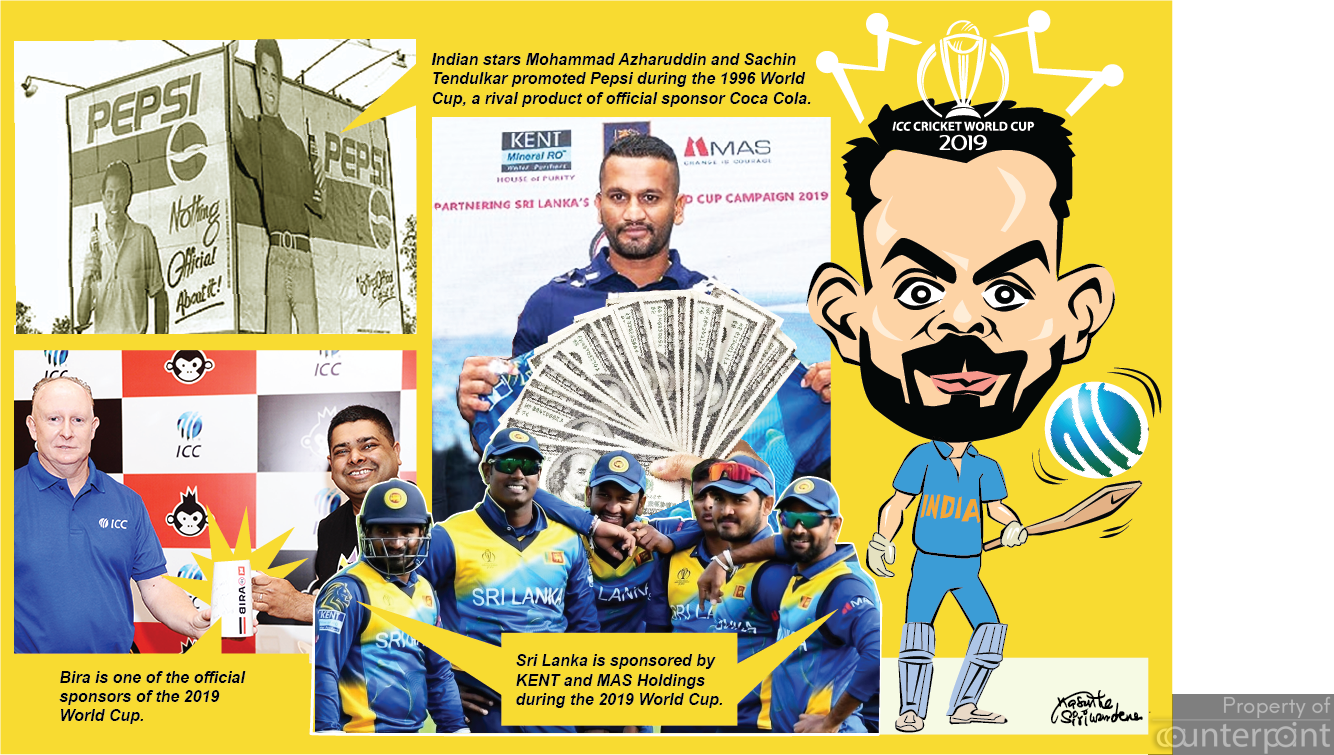The ICC Cricket World Cup has returned to England, the country that staged the first three editions of the sport’s showpiece event and the possibilities of players breaking new grounds are explored. One of the questions cricket pundits have discussed is whether any team can break the 500 run barrier.
While experts discuss a whole new set of possibilities and teams put up strategies to overcome opponents, the game’s governing body – the International Cricket Council – keeps a close eye on some key aspects that are hardly spoken of regularly. One of them is keeping the sport corruption free and another is protecting the commercial rights of its partners, who pour in millions of dollars as sponsorships.
The 1996 World Cup, held in the sub-continent, faced the first major crisis when the interests of one of the sponsors were severely affected. Coca Cola had signed up as the official sponsor and Pepsi responded with a catchy tagline – ‘Nothing official about it.’
Pepsi used up several prominent players and Bollywood actors promoting their product and during drinks breaks, when the trolley with Coke marketing all over it arrived at the grounds, the players purposely stayed away from it providing a killer blow to the official sponsor.
The ICC was forced to come up with counter measures to protect its sponsors. They were forced to include a clause in the contracts handed to the players and support staff which would safeguard the sponsors. This clause was called ‘Ambush Marketing Clause’.
This clause prevents players from signing up to promote rival products of those already signed on by the ICC. The players are banned from promoting products that are in direct competition with the sponsors of the organizers for 30 days prior and 30 days after the tournament. The rule is applicable during the event as well.
The Ambush Marketing Clause came into existence ahead of the 2003 World Cup. There was a storm of protest from players alleging loss of revenue. But with member boards having already agreed on the clause, players were left with little alternative but to sign their contracts.
Five Sri Lankan players were up in arms ahead of the 2003 tournament and SLC cut a deal agreeing to part with 25% of the money received from the ICC as participation fee. This came up to as much as US$ 1 million and it was distributed equally among the 15 players.
The practice continued for successive World Cups until this time when SLC refused to pay the players. They parted with only 300,000 US$ instead and introduced a winning bonus. For each game that Sri Lanka wins in the World Cup, the players will get an additional bonus of 50,000 US$. The players were expected to fight the new deal, but eventually, they went down without a fight as they were in a weak position to bargain, going into the World Cup on the back of some poor performances.
Protecting the interest of the sponsors is important for the game. The profits ICC makes is redistributed among member countries. Participants are set to gain US$ 4 million each from this World Cup and it is this money that is spent on developing the game.
There is anger at the ICC’s decision to reduce the number of teams at the World Cup to ten. If you go back to what prompted the ICC to reduce the event to ten teams it comes back to the point that the authorities wanted to make the most of the commercial aspect of the event.
Ever since the World Cup came into existence in 1975, the non full members of the ICC have been given an opportunity to take part in the event. Sri Lanka competed in the 1975 and 1979 World Cups without having achieved Test status. It was their exploits in the 1979 edition that expedited their Test status. Now teams have been deprived of such opportunity. Also due to the reduction of teams, some of the brightest talents of the sport like Kevin O’Brien have missed out.
But what the reduction of teams has done is that it has paved the way for the tournament to be played in its current format. The present system ensures that India play at least nine games and that brings in massive television revenue. The 2007 World Cup was a flop because India ended up playing just three games. The authorities certainly don’t want a repeat of that.
Sri Lanka Cricket for example would gain US$ 2 million for a bilateral Indian game from their television partners. What the ICC gains, that too through a World Cup, from Indian games is much more significant. This World Cup is supposed to be the financially most successful held so far.
Whether we like it or not, everyone is at the mercy of India.



 Logging you in...
Logging you in... Loading IntenseDebate Comments...
Loading IntenseDebate Comments...

